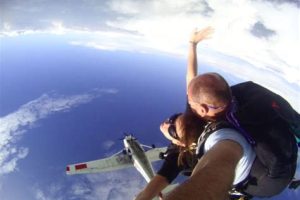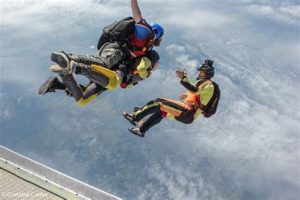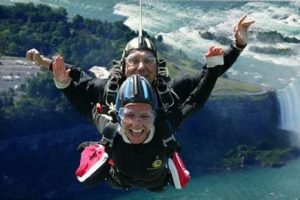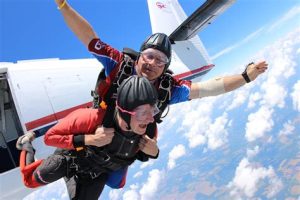Table of Contents
Skydiving Without Tandem: Experience the thrill of solo skydiving with our expert instructors. Enjoy the ultimate adrenaline rush as you freefall through the open skies, feeling the rush of wind against your face. Book your solo skydiving adventure today and take the leap into a truly unforgettable experience.
Skydiving without tandem is an exhilarating and liberating experience that allows you to truly embrace the freedom of flight. Imagine soaring through the open sky, feeling the rush of adrenaline as you leave the aircraft behind. Unlike tandem skydiving, where you are securely attached to an experienced instructor, this solo adventure gives you the opportunity to take complete control. With proper training and a fearless attitude, you can defy gravity and experience the ultimate thrill of skydiving on your own terms. So, if you’re ready to step out of your comfort zone and embark on a daring journey, let’s dive into the world of solo skydiving!
Introduction to Skydiving Without Tandem
Skydiving is an exhilarating sport that allows individuals to experience the thrill of freefalling through the sky. While many people start their skydiving journey with a tandem jump, where they are attached to an experienced instructor, there comes a time when they may want to take their skills to the next level and try skydiving without tandem. This article will provide you with instructions and guidance on how to skydive solo, ensuring you have a safe and unforgettable experience.
1. Choose the Right Skydiving School
Your first step in skydiving without tandem is to choose a reputable skydiving school that offers solo skydiving training. Look for schools that have experienced instructors, proper equipment, and a good safety record. Research online reviews and ask for recommendations from friends or fellow skydivers who have already undergone solo training.
2. Complete the Necessary Training
Before you can skydive without tandem, you must complete a comprehensive training program that covers all aspects of solo skydiving. This training typically includes ground instruction, where you’ll learn about equipment, body positioning, emergency procedures, and landing techniques. You will also practice these skills in a simulated environment before making your first solo jump.
3. Understand Equipment and Safety Procedures
It’s essential to familiarize yourself with the equipment used in solo skydiving, including the parachute, harness, altimeter, and automatic activation device (AAD). Learn how to properly inspect and adjust your gear, as well as understand safety procedures and emergency protocols. This knowledge will give you the confidence to handle any situation that may arise during your solo skydives.
4. Master Proper Body Positioning
Body positioning plays a crucial role in skydiving without tandem. Learning how to maintain a stable body position during freefall and controlling your movements is essential for a safe and enjoyable experience. Practice correct body positioning techniques during ground training and be mindful of your body posture throughout your jumps.
5. Practice Emergency Procedures
While skydiving is generally safe, it’s important to be prepared for any potential emergencies. During your training, you will learn how to handle situations like an unstable parachute, line twists, or a malfunctioning main canopy. Regularly practicing emergency procedures will help you react quickly and effectively if the need arises.
6. Understand Weather Conditions
Weather conditions can significantly impact skydiving. Before each jump, thoroughly check weather reports and consult with experienced skydivers or instructors to assess whether it is safe to jump. Strong winds, thunderstorms, or low cloud cover can make skydiving unsafe, so always prioritize your safety and follow professional advice.
7. Make Your First Solo Jump
Once you have completed all the necessary training and feel confident in your skills, it’s time to make your first solo jump. This moment will likely be a mix of excitement and nerves, but trust in the knowledge and training you have received. Remember to stay calm, follow the instructions provided by your instructors, and enjoy the incredible sensation of flying through the sky on your own.
8. Continue Training and Gain Experience
Skydiving is a skill that requires continuous learning and practice. After your first solo jump, continue to refine your skills by participating in additional training courses and jumping regularly. Each jump will contribute to building your experience and confidence, allowing you to progress to more advanced skydiving techniques, such as formation flying or canopy piloting.
9. Join a Community of Skydivers
Skydiving is not just a solo sport; it’s a vibrant community of like-minded individuals who share a passion for adrenaline and adventure. Joining a community of skydivers will provide you with support, friendship, and the opportunity to learn from experienced jumpers. Engage with fellow skydivers, participate in events, and exchange stories and advice to enhance your skydiving journey.
10. Embrace the Thrill and Enjoy the Experience
Skydiving without tandem is an incredible adventure that allows you to push your limits and experience the unparalleled freedom of flight. Embrace the thrill, savor each moment, and appreciate the breathtaking views as you soar through the sky. Remember to always prioritize safety, respect your instructors’ guidance, and cherish the remarkable memories you create during your solo skydiving experiences.
Instructions for Skydiving Without Tandem
Welcome to the instructions for undertaking a solo skydiving adventure! This guide will provide you with step-by-step directions on how to skydive without a tandem instructor, ensuring you have a thrilling and safe experience. Please read and follow these instructions carefully before attempting to skydive solo.
Gearing Up
Ensure you have the appropriate skydiving gear, including a jumpsuit, helmet, goggles, and altimeter. Also, make sure that all equipment is properly fastened and adjusted to your body for maximum comfort and safety.
Pre-Flight Check
Before boarding the aircraft, perform a thorough check of your gear, including the parachute and reserve chute. Ensure all buckles are secure, lines are untangled, and that there are no visible signs of damage or wear. If any issues are found, seek assistance from a professional skydiving instructor.
Boarding the Plane
Follow the instructions provided by the skydiving center staff to board the aircraft. Securely fasten your seatbelt and remain seated until instructed by the pilot or crew to stand up for the jump.
Exit Strategy
Once your desired altitude is reached, prepare for the jump by positioning yourself near the exit point of the aircraft. Keep your eyes on your altimeter, and when the signal is given, confidently make your exit by pushing with your legs and leaning forward, maintaining a stable posture.
Body Positioning
During freefall, remember to assume the proper body position by arching your back, keeping your arms and legs slightly bent, and your chin up. This position will aid stability and control throughout the jump.
Deploying the Parachute
When the planned altitude for chute deployment is met, using your main parachute deployment handle, forcefully pull down and away from your body. Ensure you maintain a stable body position while doing this to avoid entanglements or other complications.
Canopy Flight
Once the parachute is deployed, familiarize yourself with the flight controls and maneuver the canopy according to your desired direction. Maintain situational awareness and be mindful of any other skydivers in the vicinity by signaling your intentions and keeping a safe distance.
Landing Procedure
As you approach the ground, follow the provided guidance to prepare for a smooth and safe landing. Bend your knees slightly and keep your feet together, ready to absorb the impact. Aim for the designated landing zone, avoiding any obstacles or areas that may hinder a successful touch down.
Final Words
Skydiving without a tandem instructor is an exhilarating experience, but it is crucial to prioritize safety at all times. Remember to adhere to all guidelines offered by the skydiving center and consult with qualified professionals if you have any concerns. Enjoy your solo skydiving adventure and have a fantastic time exploring the skies!
Point of View: Skydiving Without Tandem Use Instructions
When it comes to skydiving without tandem use instructions, there are several important points to consider. This exhilarating adventure requires careful planning, preparation, and a comprehensive understanding of the necessary skills and safety measures. In this article, we will explore the significance of proper instructions, including the voice and tone utilized during the training process.
- Clarity: The voice and tone used in skydiving instructions should be clear and concise. It is crucial for instructors to express themselves in a manner that is easily understood by the participants. Using simple language and avoiding jargon ensures that everyone comprehends the information accurately.
- Encouragement: Skydiving can be an intimidating experience for many individuals. Therefore, it is essential for instructors to adopt an encouraging and supportive tone. By providing positive reinforcement and instilling confidence in participants, instructors can help alleviate any apprehensions and create a more relaxed atmosphere during the training process.
- Focus on Safety: Skydiving is an extreme sport that involves certain risks. Consequently, the voice and tone used in instructions must emphasize the importance of safety measures. Instructors should convey the potential dangers associated with skydiving without inducing fear. By striking a balance between cautionary advice and reassurance, participants can develop a strong awareness of safety protocols.
- Step-by-Step Guidance: Given the complexity of skydiving, instructors should provide step-by-step instructions to ensure a smooth and successful experience. The voice and tone used should be authoritative yet approachable, guiding participants through each stage of the process. By breaking down the skydiving procedure into manageable parts, instructors can help participants grasp the techniques and skills required.
- Engaging and Interactive: To enhance the learning experience, the voice and tone used in skydiving instructions should be engaging and interactive. Instructors can incorporate storytelling, anecdotes, and real-life examples to captivate participants’ attention. Encouraging questions and discussions fosters an interactive environment, allowing individuals to actively participate in the training process.
In conclusion, skydiving without tandem use instructions requires a well-defined voice and tone that prioritize clarity, encouragement, safety, step-by-step guidance, and engagement. By utilizing these elements effectively, instructors can ensure a comprehensive and enjoyable training experience for participants. Remember, a successful skydive begins with thorough instructions that empower individuals to conquer their fears and embrace the breathtaking adventure that awaits them in the sky.
Thank you for visiting our blog and taking the time to learn more about skydiving without tandem! We hope the information provided has been helpful in giving you a better understanding of this exhilarating adventure. Before you take the leap, we want to provide you with some important instructions to ensure your safety and enjoyment during your solo skydiving experience.
First and foremost, it is crucial to undergo proper training before attempting to skydive without a tandem instructor. This involves completing a comprehensive course that covers all the necessary skills and knowledge required for a successful solo jump. The training will teach you about equipment usage, body positioning, emergency procedures, and other essential aspects of skydiving. It is essential to pay close attention during the training sessions and ask any questions you may have. Remember, safety should always be your top priority!
Once you have completed your training, you will need to obtain the necessary certification to skydive solo. This typically involves passing a written exam and demonstrating your skills in a series of jumps under the supervision of an experienced instructor. Obtaining your certification not only ensures your safety but also allows you to enjoy the freedom and excitement of skydiving without relying on a tandem instructor.
When it comes to your actual solo skydiving experience, there are a few key things to keep in mind. Firstly, it is crucial to carefully inspect your gear before every jump. This includes checking the condition of your parachute, harness, and other equipment. If you notice any signs of damage or wear, it is essential to address them immediately and seek professional assistance if needed.
Additionally, always double-check your altitude and ensure you have a clear understanding of the landing area. It is crucial to maintain awareness of your surroundings throughout the entire jump, as this will help you make informed decisions and react appropriately to any unexpected situations. Lastly, remember to enjoy the breathtaking views and the incredible sensation of freefalling – after all, skydiving is a once-in-a-lifetime experience that few have the privilege of enjoying!
We hope these instructions have provided you with valuable insights into the world of skydiving without tandem. Remember, practice makes perfect, and with dedication, training, and proper safety measures, you can embark on this extraordinary journey with confidence. So, gear up, prepare yourself mentally and physically, and get ready for an unforgettable adventure in the skies!
.
People also ask about Skydiving Without Tandem:
-
What is skydiving without tandem?
Skydiving without tandem refers to a solo skydiving experience where you jump out of an aircraft without being attached to an instructor or tandem master. It allows individuals to experience the thrill and freedom of freefalling and parachuting on their own.
-
How do I prepare for skydiving without tandem?
To prepare for skydiving without tandem, follow these instructions:
- Find a reputable skydiving center that offers solo jumps and inquire about their requirements.
- Complete any necessary paperwork and waivers.
- Undergo a comprehensive training session where you’ll learn about safety procedures, equipment usage, body positioning, and emergency protocols.
- Practice in a simulated environment, including mock exits from an aircraft and practicing parachute deployment.
- Ensure you meet the minimum age and health requirements specified by the skydiving center.
- Stay mentally focused and calm before the jump, following any additional instructions provided by your instructors.
-
What equipment will I need for skydiving without tandem?
For skydiving without tandem, you’ll typically need the following equipment:
- A jumpsuit to protect your clothing and provide aerodynamic benefits.
- A helmet to ensure head protection during the jump.
- A properly fitted parachute system, including the main canopy, reserve parachute, and harness.
- An altimeter to measure your altitude during the jump.
- A radio or audible altimeter for receiving instructions or alerts from the ground crew.
-
How much does skydiving without tandem cost?
The cost of skydiving without tandem can vary depending on several factors, such as location, altitude, additional services, and training included. On average, solo skydiving experiences can range from $200 to $400.
-
Is previous skydiving experience required for skydiving without tandem?
While previous skydiving experience is not always required for skydiving without tandem, most skydiving centers will require you to complete a certain number of tandem jumps or undergo accelerated freefall (AFF) training before allowing you to jump solo. This ensures you have the necessary skills and knowledge to perform a safe solo jump.






